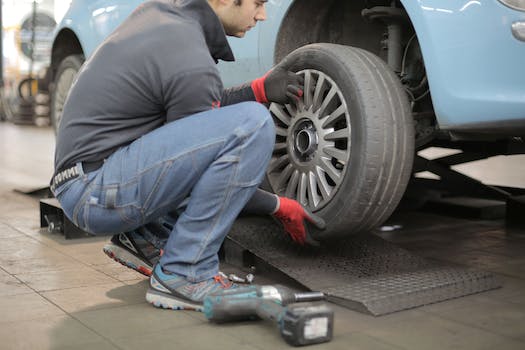
A Comprehensive Guide to Tire Maintenance and Buying
-
Table of Contents
“Keep your tires rolling with our guide to tire maintenance and buying!”
Introduction
A Comprehensive Guide to Tire Maintenance and Buying is a comprehensive guide to help you understand the importance of tire maintenance and buying. It covers everything from the basics of tire maintenance to the different types of tires available and how to choose the right one for your vehicle. It also provides tips on how to save money when buying tires and how to extend the life of your tires. This guide will help you make informed decisions when it comes to tire maintenance and buying, so you can get the most out of your tires.
How to Inspect Your Tires for Wear and Tear
Maintaining your tires is an important part of vehicle ownership. Regularly inspecting your tires for wear and tear can help you identify potential problems before they become serious. Here are some tips for inspecting your tires for wear and tear.
1. Check the Tread Depth: The tread depth of your tires is an important indicator of their condition. You can check the tread depth with a tread depth gauge or a penny. Place the gauge or penny into the tread grooves of your tire. If the top of Lincoln’s head is visible, your tread depth is below 2/32 of an inch and it’s time to replace your tires.
2. Look for Uneven Wear: Uneven wear can be caused by a variety of factors, including improper tire inflation, misalignment, or worn suspension components. Look for signs of uneven wear, such as bald spots or cupping. If you notice any of these signs, it’s time to have your tires inspected by a professional.
3. Check for Cracks and Bulges: Cracks and bulges in your tires can be caused by age, exposure to extreme temperatures, or a puncture. Inspect your tires for any signs of cracking or bulging. If you notice any, it’s time to replace your tires.
4. Look for Foreign Objects: Foreign objects, such as nails or screws, can become lodged in your tires and cause a puncture. Inspect your tires for any foreign objects that may have become lodged in the tread. If you find any, it’s time to have your tires inspected by a professional.
By regularly inspecting your tires for wear and tear, you can help ensure that your tires are in good condition and that you’re driving safely. If you have any questions or concerns about the condition of your tires, it’s best to have them inspected by a professional.
The Benefits of Regular Tire Rotations
Regular tire rotations are an important part of vehicle maintenance that should not be overlooked. Rotating your tires on a regular basis can help extend the life of your tires, improve your vehicle’s performance, and even save you money in the long run.
One of the main benefits of regular tire rotations is that it helps to extend the life of your tires. When tires are rotated, the tread wears more evenly, which helps to prevent premature wear and tear. This can help you get more miles out of your tires before they need to be replaced.
Regular tire rotations can also help to improve your vehicle’s performance. When tires are rotated, the weight of the vehicle is distributed more evenly, which can help to improve handling and braking. This can make your vehicle safer to drive and can also help to improve fuel efficiency.
Finally, regular tire rotations can help to save you money in the long run. By rotating your tires on a regular basis, you can help to extend the life of your tires and avoid having to replace them prematurely. This can save you money on tire purchases and can also help to reduce the cost of other maintenance services, such as wheel alignments.
Overall, regular tire rotations are an important part of vehicle maintenance that should not be overlooked. By rotating your tires on a regular basis, you can help to extend the life of your tires, improve your vehicle’s performance, and even save you money in the long run.
How to Choose the Right Tire for Your Vehicle

When it comes to choosing the right tire for your vehicle, there are a few important factors to consider. The right tire can make a big difference in the performance and safety of your vehicle, so it’s important to make sure you’re selecting the right one. Here are some tips to help you choose the right tire for your vehicle.
1. Consider Your Vehicle’s Make and Model: Different vehicles require different types of tires. Make sure you’re selecting a tire that’s designed for your specific make and model.
2. Consider Your Driving Habits: Different tires are designed for different types of driving. If you’re an off-road enthusiast, you’ll need a tire that’s designed for off-road use. If you’re a city driver, you’ll need a tire that’s designed for city driving.
3. Consider Your Budget: Tires can range in price from very affordable to very expensive. Make sure you’re selecting a tire that fits within your budget.
4. Consider Your Climate: Different tires are designed for different climates. If you live in an area with extreme temperatures, you’ll need a tire that’s designed for those conditions.
5. Consider Your Tread: Different tires have different tread patterns. Make sure you’re selecting a tire with the right tread pattern for your driving needs.
By following these tips, you can make sure you’re selecting the right tire for your vehicle. The right tire can make a big difference in the performance and safety of your vehicle, so it’s important to make sure you’re selecting the right one.
The Pros and Cons of Buying Used Tires
When it comes to buying tires, there are many factors to consider. One of the most important decisions is whether to buy new or used tires. While used tires can be a great way to save money, there are some potential drawbacks to consider. In this blog post, we’ll explore the pros and cons of buying used tires.
Pros
Cost Savings: The most obvious benefit of buying used tires is the cost savings. Used tires are typically much cheaper than new ones, so if you’re on a tight budget, this can be a great way to save money.
Durability: Used tires are often just as durable as new ones, so you don’t have to worry about them wearing out quickly.
Environmental Benefits: Buying used tires is also better for the environment. By reusing tires, you’re helping to reduce the amount of waste that goes into landfills.
Cons
Safety: One of the biggest drawbacks of buying used tires is the potential safety risks. Used tires may not have the same level of traction and handling as new ones, so you could be putting yourself at risk if you don’t inspect them carefully.
Lack of Warranty: Used tires typically don’t come with a warranty, so if something goes wrong, you’ll be responsible for the cost of repairs or replacements.
Unknown History: When you buy used tires, you don’t know how they’ve been used or maintained in the past. This could lead to unexpected problems down the road.
Overall, buying used tires can be a great way to save money, but it’s important to weigh the pros and cons carefully before making a decision. Be sure to inspect the tires thoroughly and consider the potential safety risks before making a purchase.
Tips for Storing Tires During the Off-Season
If you’re an avid car enthusiast, you know that storing your tires during the off-season is essential for keeping them in good condition. Here are some tips to help you store your tires properly during the off-season:
1. Clean your tires: Before storing your tires, make sure to clean them thoroughly. This will help prevent dirt and debris from building up and damaging the tires.
2. Store in a cool, dry place: Make sure to store your tires in a cool, dry place away from direct sunlight. This will help prevent the tires from drying out and cracking.
3. Use tire covers: Invest in some tire covers to protect your tires from dust and dirt. This will also help keep the tires from drying out and cracking.
4. Check the air pressure: Make sure to check the air pressure of your tires before storing them. This will help ensure that the tires are properly inflated and ready to go when you need them.
5. Rotate the tires: Rotating your tires every few months will help prevent uneven wear and tear. This will also help keep the tires in good condition for longer.
Following these tips will help ensure that your tires are in good condition when you need them. Storing your tires properly during the off-season will help extend their life and keep them in good condition for years to come.
Q&A
1. What are the benefits of regular tire maintenance?
Regular tire maintenance helps to ensure that your tires are in good condition and can help to extend their life. It can also help to improve your vehicle’s performance and fuel efficiency, as well as reduce the risk of a tire blowout or other tire-related issues.
2. What should I look for when buying new tires?
When buying new tires, you should consider the size, type, and load rating of the tires. You should also consider the tread pattern and the type of terrain you will be driving on. Additionally, you should look for tires with a good warranty and a good reputation for quality.
3. How often should I rotate my tires?
It is recommended that you rotate your tires every 5,000 to 8,000 miles, or every 6 months, whichever comes first.
4. What is the best way to store my tires?
The best way to store your tires is in a cool, dry place away from direct sunlight. You should also make sure that the tires are not exposed to extreme temperatures or moisture.
5. What should I do if I experience a tire blowout?
If you experience a tire blowout, you should pull over to a safe area and turn on your hazard lights. You should then call for roadside assistance or a tow truck to help you change the tire.
Conclusion
A Comprehensive Guide to Tire Maintenance and Buying is an invaluable resource for anyone looking to keep their tires in top condition and make informed decisions when it comes to purchasing new tires. It provides detailed information on how to properly maintain tires, how to choose the right tires for your vehicle, and how to save money when buying tires. With this guide, you can be sure that your tires will last longer and perform better, while also saving you money in the long run.






